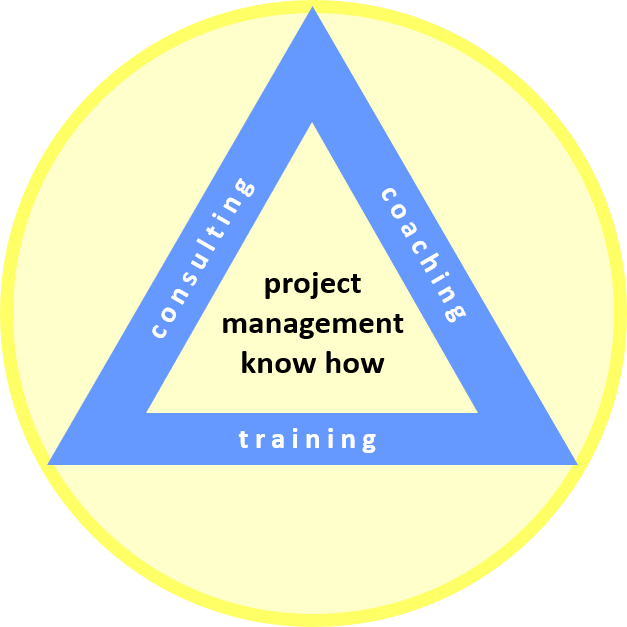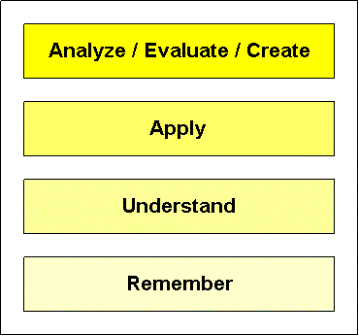- Home
- Project Portfolio
- Learning in Organizations
Learning in Organizations
Published: 2010-06-03
Last updated: 2022-03-20
Most of the learning in organizations we achieve by doing our daily work and reflecting upon it: this is what we call learning by doing. We can support and accelerate this natural learning by offering a structured curriculum of seminars, courses or training programs for staff members, managers and executives.
(1) Learning By Doing
How do we achieve most of our organizational learning? Facing a problem, we create a solution which we repeat for similar problems if it works. If it does not we change and adapt and create alternative solutions until we find one that works. This fundamental approach includes an open environment in which we can make mistakes, get timely feedback and the opportunity to apply our lessons learned. In case we have to expect "punishment" for our mistakes, our learning will rather focus on skillful finger pointing and inventing excuses or we will avoid trying to solve problems altogether.
Consequently, we shall setup our organizational environment in a way that allows for mistakes, corresponding feedback and opportunities to do it better next time.
On the other hand, a profit oriented organization cannot tolerate too many of those mistakes. How can we solve that dilemma without punishment? In order to avoid negative side effects of mistakes, like additional cost or time delays, we apply training.
(2) Learning in Seminars and Training Programs
We support learning in organizations by training which provides an experimental environment. There, we can make mistakes and get immediate feedback without "punishment".
The classical form of such training is a seminar of a few days
that consists of a number of modules, each of which following these four
basic steps:
- instructions (e.g. how to solve a certain type of problems), given by a trainer
- exercise with problem solving for a special case, done by the participants
- presentation of the results, given by the participants
- evaluation of results in form of feedback and comments by the trainer or a group discussion facilitated by the trainer
Mistakes in a seminar are not dangerous and definitely do not generate additional cost or time delays, other than the cost of the seminar itself – correct?
Yes, correct, but only under the condition that the participants successfully transfer their learning into their working environment.
This works fairly well for training of basic skills and in organizations where we expect our staff doing highly repetitive work. For training of skills on higher levels and in organizations with fast changing environment, especially in project oriented organizations, where most of the work is non-repetitive we need other approaches than only classical seminars as described above.
(3) Interval Training
A lot of learning in organizations includes acquiring sustainable behavioral changes: for example, participants of a 5-day project management seminar run through a sequence of instructions and exercises to teach them understand, appreciate and practice the skill set of planning and delegating work packages. In their real life project context after the seminar, one important aspect for most participants is their ability "to let go", not falling back to the "old habit" of doing parts or all of the delegated work themselves again.
We found that behavioral change is much more sustainable by giving the participants the opportunity to apply new skills in real life situations and re-visit, evaluate and discuss their experiences some weeks later again.
We characterize this learning approach by alternating between intensive but short (WS 1 and WS 2) and extensive but longer intervals (Transfer phase). For more complicated skill sets or in case we want to change more deeply rooted habits into new behavior, we need more of these intervals.
Each interval, i.e. each one of the workshops WS 1, WS 2, etc., takes only a few days while the extensive transfer phases between these workshops take several weeks, even a couple of months. In a best case scenario, we combine stand-alone seminars for basic training with training programs where we apply interval training.
(4) Levels of Learning
Like in any learning context, we need a reference model for learning in organizations as well, and we apply the taxonomy of educational objectives. When introduced first by B. Bloom et al. in 1956, it described a hierarchical order of learning objectives in the domain of cognitive learning. Here, we refer to L. W. Anderson, D. R. Krathwohl et al.: A Taxonomy for Learning, Teaching, and Assessing — A Revision of Bloom's Taxonomy of Educational Objectives; Addison Wesley Longman, Inc. 2001.
We use this taxonomy in order to describe which ability we would like participants to acquire in a seminar or training unit. These are the four levels of learning objectives:
On the lowest level, participants are able to remember pure facts, process descriptions, model solutions to certain problems, etc.
On the second level, participants are able to understand the wider context of facts, or explain processes, problem solutions, etc. in their own words.
On the third level, participants are able to apply or combine their knowledge of facts, processes and methods to find solutions to new problems.
On the highest level, participants are able to analyze and evaluate problems and situations, and create new processes or solutions.
Central proposition of this model is that we cannot achieve a learning goal on a certain level if we have not yet accomplished all corresponding learning goals on the lower levels. This has far-reaching consequences on design and development of individual seminars and training programs.
(5) Structured Curriculum
Another important aspect of learning in organizations is how we organize and coordinate all the learning events as a whole.
Best practice is a structured curriculum. It includes specific seminars and training programs for staff members, managers and executives. All elements of such a curriculum are set up and coordinated so that they complement each other and build upon each other. Suppliers of all those learning events can be internal or external to the organization, or a combination of the two.
(6) Learning Transfer
The most critical phase of learning in organizations starts at the end of a seminar or learning program when the participants return to their working place and want to transfer and integrate their learning into their daily life working practice. We often see them falling back into their "old" habits and behavior. This fallback effect is quite understandable since the environment usually is the "old" one.
From our observation, the best way to avoid that fallback is to give participants the opportunity to take mentoring by experienced colleagues or coaching by neutral coaches. Both, mentoring as well as coaching re-affirm participants in their new and different approach to solving problems, managing processes, etc.
(7) Training Management Process
Within a structured approach to learning in organizations, the setup of seminars and training programs follows a generic process.
We differentiate mainly two groups of training requirements: organizational needs (like increasing sales, revenue, profit figures, etc.) and individual needs (like acquiring knowledge and skills, personal development, better career opportunities, etc.).
An organization can design seminars or training programs on an in-house basis, sub-contract it to external vendors, or combine both.
Similarly, they can deliver the seminars and training programs via an internal training department, external training vendors, or choose a combination.
Return to Project Portfolio Management
Return from Learning in Organizations to Home Page
|
|
|





Your Comments
Have your say about what you just read! Leave me a comment in the box below.